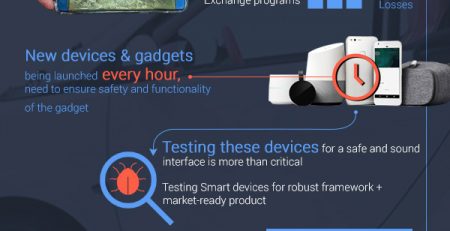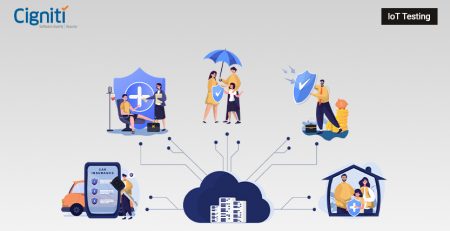Wearable Technology is the Access to Healthcare Future
Healthcare and Lifesciences industry is metamorphosizing into an evolved, digitally-advanced, technology-driven, consumer-centric sector. As against the existing uptightness toward digital adoption, the industry is burgeoning with innovative solutions for delivering enhanced care to the patients. Coming out of its shell and dissolving the silos, healthcare sector is openly and widely embracing the digitally disruptive processes. This is evident from the favorable statistics showcasing that over 1800 hospitals in the U.S. utilize mobile applications, while 92% of the hospitals have a patient portal solution in place.
As the consumerism attitude is settling in amongst the patients, they seek convenient healthcare. The modern, tech-savvy, price-sensitive patients expect first-class care delivery at minimal efforts and affordable rates. A recent study by Definitive Healthcare revealed that 70% of consumers would rather use video consulting than visit their primary care provider in person. With the rising popularity of telehealth, mHealth or digital health, hospitals are also equipping themselves with the required solutions. 50% of the U.S. hospitals offer the telehealth facility to their patients. The remote patient monitoring market is driven to become a $31.3 Billion industry. This surge is proportionally resulting in the proliferation of the wearables market, which is projected to grow 15.3% over the previous year to 198.5 Million units by the end of 2019.
Wearable technology in healthcare are undergoing a shift from simply being fitness trackers to real-time clinical monitors. This evolving landscape is expected to result in an annual industry-wide expenditure of $20 Billion on health trackers and remote patient monitoring devices by 2023. Smart watches, fitness trackers, wrist bands, movement sensors, smart footwear, wearable patches may seem like a luxury today, but will define the healthcare industry of tomorrow.
What is driving this rapid growth of medical wearables?
We are headed to a connected future. Wearable devices are simply the enablers and propagators of that tomorrow, especially in healthcare, where telemedicine is slowly coming parallel to in-person consultation. The advancements in the Artificial Intelligence solutions is further fueling the exponential growth of the wearables.
In addition to offering convenient, home delivery of healthcare services, these fitness-turned-clinical trackers armor care providers to obtain data on real-time activity and vitals of the patients. The extensive reach of smartphones has further aided the growing popularity of wearable devices. Instrumental in prevention, monitoring, and treatment of a patient’s medical conditions, connected wearable devices in healthcare are utilizing IoT and data analytics to enhance quality and expectancy of life.
The sophisticated sensors in these devices collect patient data and transmit it over to the care providers for optimal tracking of medical conditions. This channel established by the devices is particularly critical for monitoring and responding to life-threatening conditions such as cardiac diseases and Chronic Obstructive Pulmonary Disease (COPD). Medical wearables are looking extremely promising for adult and mental healthcare delivery as they enable remote monitoring and notify medical practitioners in case of an emergency.
What is hindering their widespread adoption?
Data privacy remains the largest obstacle on the road to widespread popularity of medical wearable devices. Most users are not comfortable with an AI-based sensor keeping record of their every moment. Although there is an increase in the people allowing these devices to penetrate their privacy, there is still a long way to go for wearable devices to become mainstream. The concern of confidentiality is, however, equal on both the fronts of care receivers and providers. The healthcare sector used to exist in siloed structure for the protection of intimate data of the patients. Now that they have emerged out of those silos, the safeguarding of user data has taken even more priority.
High costs of wearable devices in healthcare are another roadblock in their adoption. Instead of a necessity, they are more deemed as a luxury that is not affordable for the maximum section of the society. Probably, with the advent of smarter technologies, the costs will go down in the future. As of now, the wearables remain out of reach for the majority.
The high stakes involved in the application of wearable devices in healthcare make accuracy and reliability the top priority. There might be serious consequences, sometimes fatal, if a device is faulty, sends out false alarms, unable to transmit data correctly, or fails to correctly analyze health conditions of the wearer.
What does the technology mix driving wearable devices comprise?
Internet of Things and Artificial Intelligence are the wheels of the wearables industry. The interconnectivity of the IoT technology ensures transmission of data over the multiple nodes. It is critical that a reliable connection is established between the user’s wearable device and the care provider’s monitor. The deployment of Artificial Intelligence here is essential for comprehending the transmitted data and convert it into actionable information.
On top of the AI-driven IoT technology, healthcare wearables are all set to employ Augmented Reality to further enhance a patient’s experience in receiving remote healthcare. With the help of AR, the medical practitioners will be able to mimic an in-person consultation while analyzing a patient’s condition.
For the effective realization of a smart, AI and AR-based healthcare delivery, the central pillar remains Quality Engineering and software testing. The wearable device manufacturers must shoulder the responsibility to deploy a glitch-free product.
IoT testing is essential to guarantee that every unit works in absolute tandem with the other and channels the information properly. The involvement of multiple nodes opens up the possibility of bigger breaches, which make the security recceing of the IoT devices indispensable. The AI-driven wearable devices and their sensors are required to be thoroughly tested for assuring the quality, performance and operability in the real-life environment.
Cigniti offers Healthcare and LifeSciences software testing solutions for diverse lifescience and healthcare players such as hospitals, pharmaceutical companies, healthcare services, clinical labs, hospitals, and research organizations. Cigniti has a Healthcare and LifeSciences Software Testing Center of Excellence (CoE) and a specific Hospital Application Test Approach that helps our clients gain immense business value in Healthcare and LifeSciences software testing, automation, mobile applications testing, Connected Health IoT, and Regulatory Testing. Contact us for Advisory & Transformation services, Test Automation, and Performance, Functional, and Security Testing solutions.





Leave a Reply